Are you searching for a dog breed that is as spirited as a flame, yet fiercely loyal? Look no further than the Irish Terrier. With their distinctive wiry coat and vibrant red or wheaten colors, these medium-sized dogs exude a captivating charm.
But there's more to the Irish Terrier than just their appearance. In this discussion, we will uncover the fascinating information and characteristics of this breed, including their temperament, exercise needs, training requirements, and common health problems.
But that's not all – there's a hidden secret waiting to be revealed about the Irish Terrier that will leave you eager to learn more.
Key Takeaways
- Irish Terriers are a feisty and loyal breed known for their adaptability and fearless courage.
- They have moderate exercise needs and require early and consistent training.
- Irish Terriers may be suitable for apartment living if they have low energy levels, are quiet, and well-mannered towards neighbors.
- Potential health issues to be aware of include hip dysplasia, elbow dysplasia, and eye problems.
Origin and Size
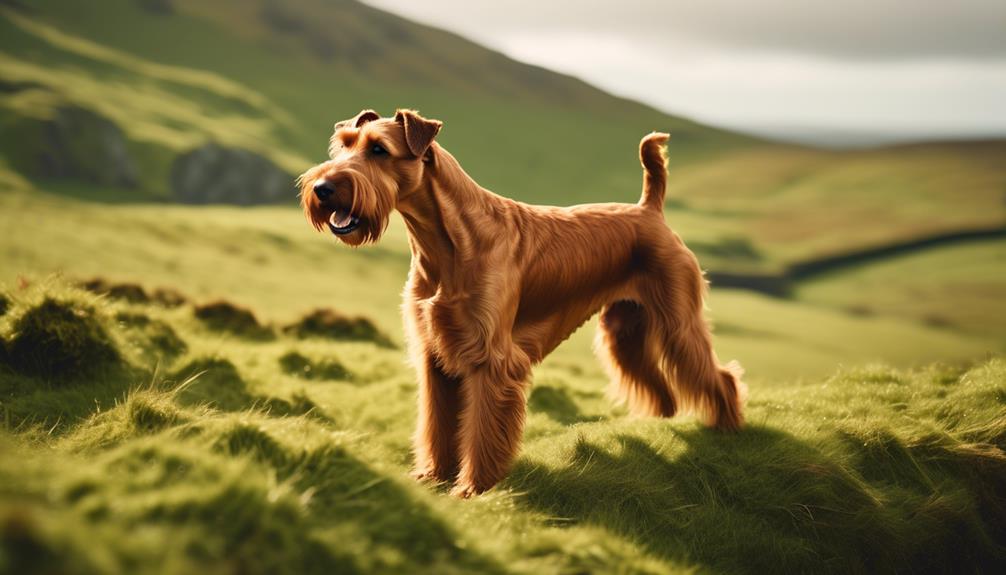
The Irish Terrier, originating from Ireland, is a medium-sized breed known for its unique characteristics and history. This breed has a rich heritage that dates back many years.
The Irish Terrier is one of the oldest Terrier breeds and emerged as a recognized breed in 1875. Its ancestors include the now-extinct black and tan Terrier and a larger wheaten-colored terrier.
In terms of size, the ideal weight for males is 27 pounds and for females is 25 pounds. They stand at a height of 18 to 20 inches at the shoulder.
Despite their medium size, Irish Terriers are known for their fearless and spirited nature, making them a remarkable breed with a fascinating history.
Breed Group and Lifespan
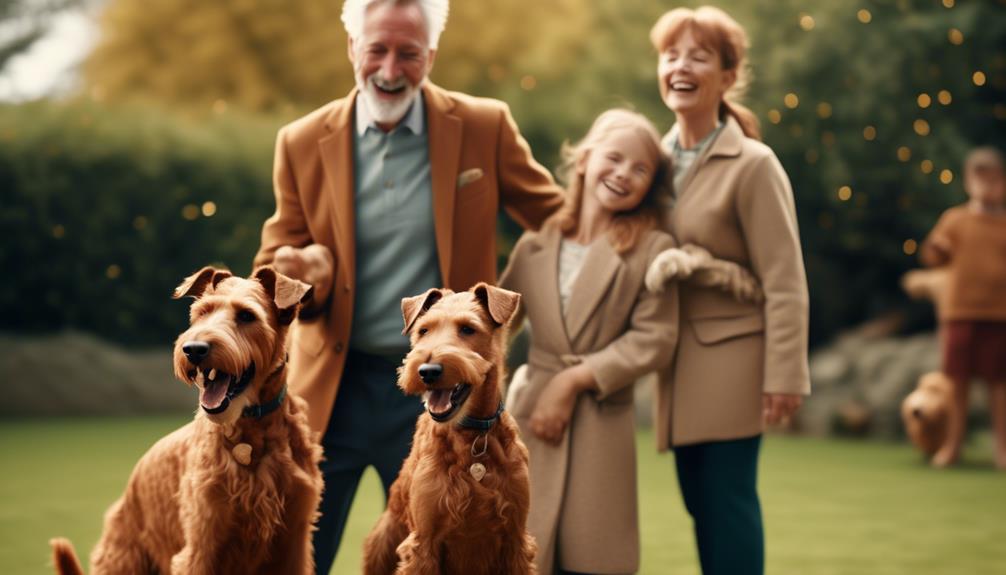
Now let's explore the breed group and lifespan of the Irish Terrier, shedding light on their classification and how long they typically live.
- Breed Group: Terrier
- Lifespan: 12-15 years
Irish Terriers belong to the Terrier breed group, known for their feisty and spirited nature. They're fearless and adaptable, making them excellent messenger and sentinel dogs during World War I.
On average, Irish Terriers live between 12 to 15 years. This means that they can be a long-term companion for you and your family, bringing joy and loyalty to your lives for many years to come.
Coat and Temperament
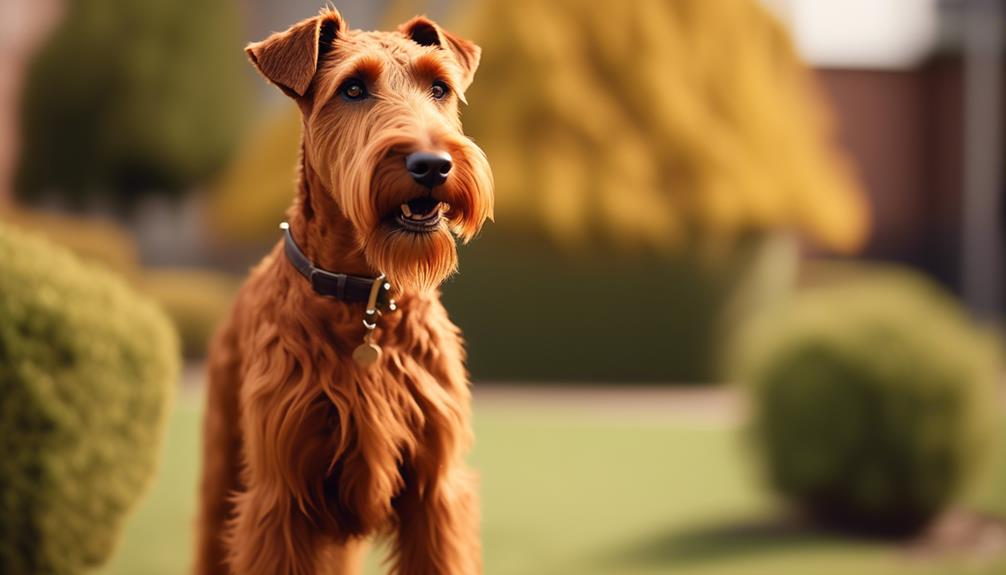
If you're curious about the Irish Terrier's coat and temperament, you'll be pleased to know that they have a wiry, double coat and are known for being feisty and loyal. The Irish Terrier's coat is dense and wiry, with a soft undercoat. It comes in bright red, golden red, red wheaten, or wheaten colors. Puppies may have black hair at birth, but it should disappear as they grow. Irish Terriers shed very little and are sometimes considered nonallergenic. They are known for their feisty and spirited nature, as well as their loyalty and intelligence. Irish Terriers require plenty of attention, patience, and space to move. They are playful and make great companions for active individuals or families.
| Coat | Temperament |
|---|---|
| Wiry, double coat | Feisty |
| Dense and wiry, with a soft undercoat | Loyal |
| Comes in bright red, golden red, red wheaten, or wheaten colors | Intelligent |
| Puppies may have black hair at birth | Spirited |
| Shed very little | Playful |
Exercise Needs and Training
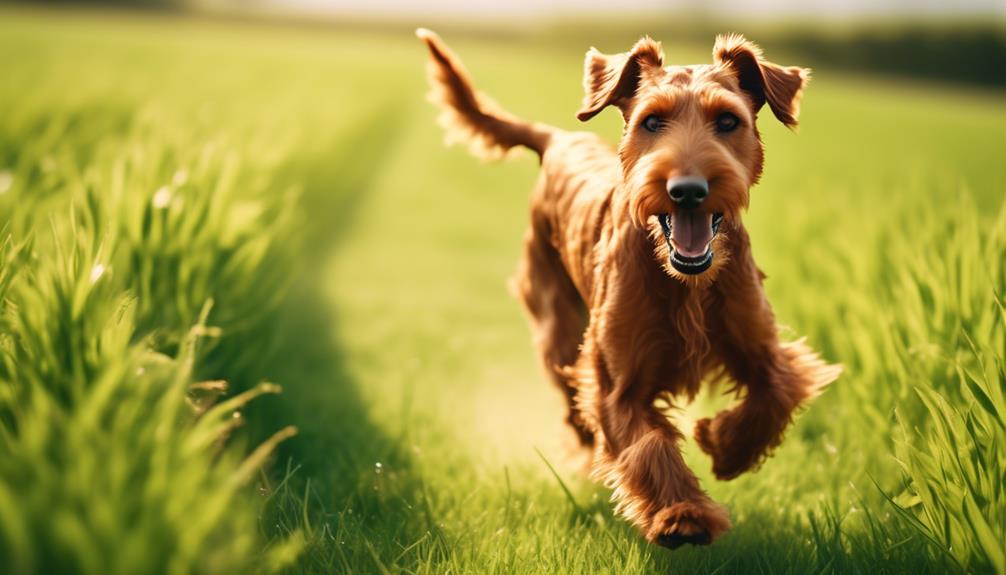
To ensure a well-behaved and happy Irish Terrier, it's important to meet their exercise needs and provide consistent training. Here are some key points to consider:
- Daily exercise: Irish Terriers have moderate exercise needs and should be given at least one to two walks per day.
- Mental stimulation: Engage their intelligent minds with puzzle toys and interactive games to prevent boredom.
- Obedience training: Start training early and be consistent with commands and boundaries to establish good behavior.
- Socialization: Expose your Irish Terrier to different people, animals, and environments to promote their social skills.
Common Health Problems
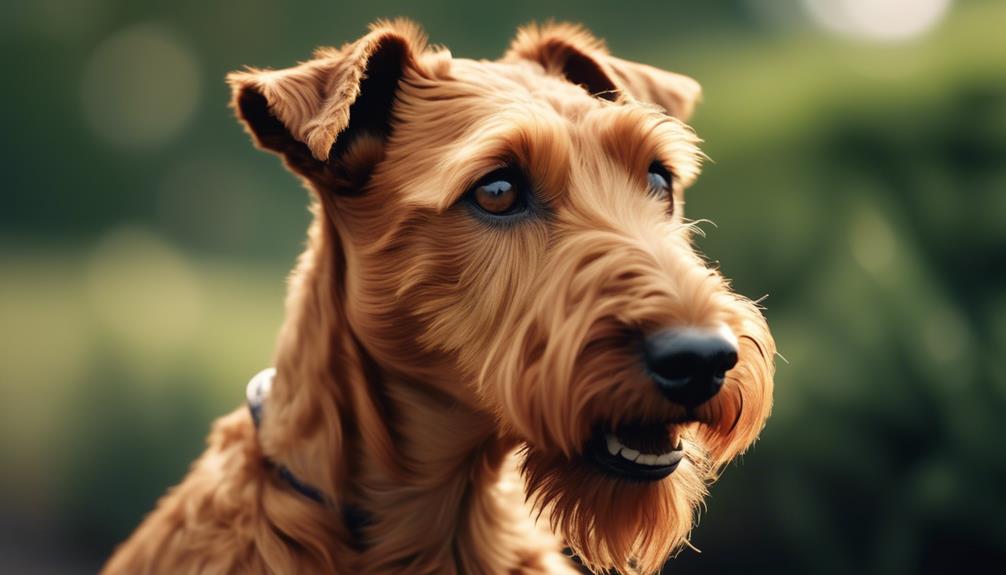
One important aspect to consider when owning an Irish Terrier is being aware of the common health problems associated with the breed. While Irish Terriers are generally considered a healthy breed, there are a few conditions that they may be prone to.
One of the common health problems is hip dysplasia, which is a condition where the hip joint doesn't develop properly, leading to discomfort and mobility issues.
Another common health problem is elbow dysplasia, which affects the elbow joint and can cause pain and lameness.
Irish Terriers may also be susceptible to eye problems, such as cataracts and progressive retinal atrophy.
It's important to monitor your Irish Terrier's health and seek veterinary care if any symptoms or concerns arise.
Irish Terrier in Pop Culture

The Irish Terrier has made its mark in pop culture, captivating audiences with its spirited personality and distinctive appearance. This charming breed has been featured in various forms of media, showcasing its unique qualities.
Here are some notable appearances of the Irish Terrier in pop culture:
- In the 2007 movie 'Firehouse Dog,' the lead role is portrayed by an Irish Terrier, exemplifying its intelligence and adaptability.
- The Irish Terrier gained a reputation for its fearless courage and loyalty, serving as a messenger and sentinel dog during World War I.
- In literature, the Irish Terrier has been depicted in books and stories, showcasing its feisty and playful nature.
- The breed has also been featured in advertisements, demonstrating its appeal and charm to a wide audience.
These instances highlight the Irish Terrier's enduring popularity and its ability to capture the hearts of people through its vibrant personality and striking appearance.
Factors to Consider for Apartment Living
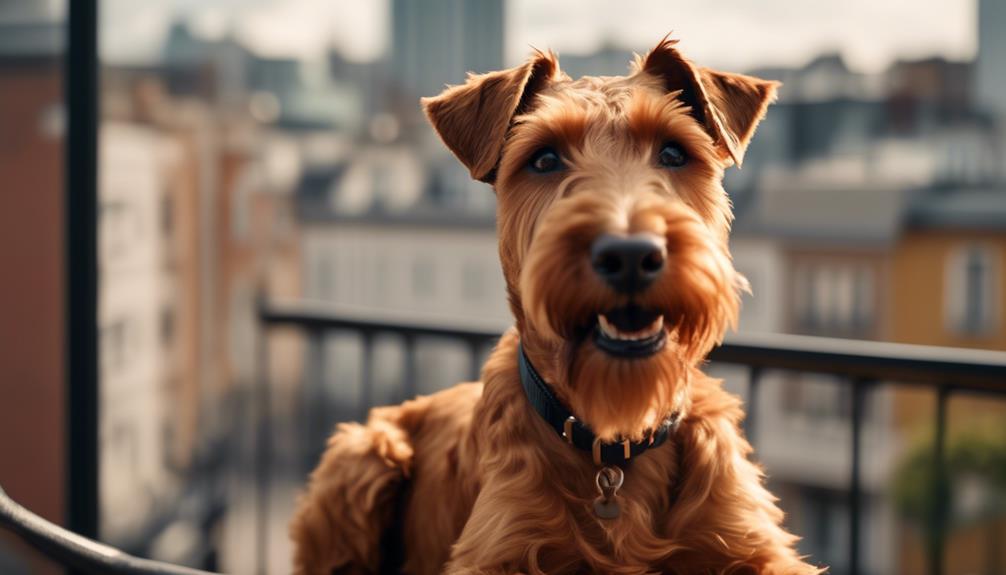
Before we dive into the factors to consider for apartment living, let's explore the unique characteristics and history of the Irish Terrier.
The Irish Terrier is known for its adaptability, loyalty, spirited nature, and fearless courage. When it comes to apartment living, this breed generally adapts well. However, suitability for apartment living goes beyond size.
Factors such as barking and behavior towards neighbors should be considered. Small dogs with high energy may not be suitable for apartment living. Desirable qualities in an apartment dog include being quiet, low-energy, and polite towards other residents.
Size alone shouldn't be the sole determinant when choosing a dog for an apartment. It's important to consider the energy levels and space requirements of different breeds, as well as prioritize qualities such as being quiet, low-energy, calm indoors, and well-mannered to ensure a harmonious living environment.
Desirable Qualities in an Apartment Dog
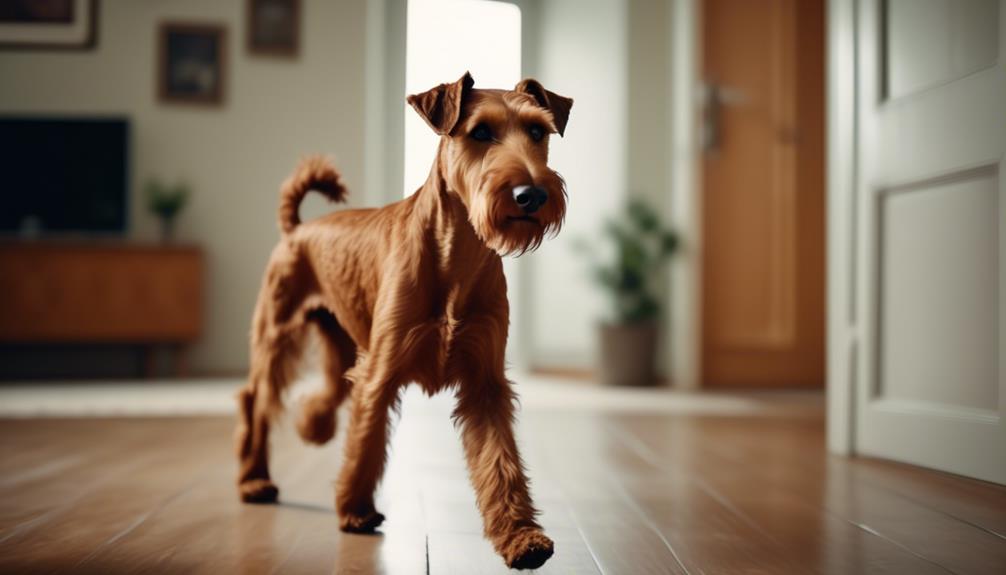
Consider the ideal qualities in an apartment dog, such as being quiet, low-energy, and polite towards other residents. When choosing a dog for apartment living, it's important to prioritize certain characteristics to ensure a harmonious living environment. Here are some desirable qualities to look for:
- Quiet demeanor: A dog that doesn't bark excessively will be more suitable for apartment living.
- Low-energy level: Dogs with lower energy levels are more likely to adapt well to a smaller living space.
- Calm indoors: Look for a dog that's content to relax and be calm indoors, without the need for constant stimulation.
- Well-mannered: A dog that's polite towards other residents, both humans and animals, will help maintain a peaceful living environment.
Irish Terrier Personality and Interaction
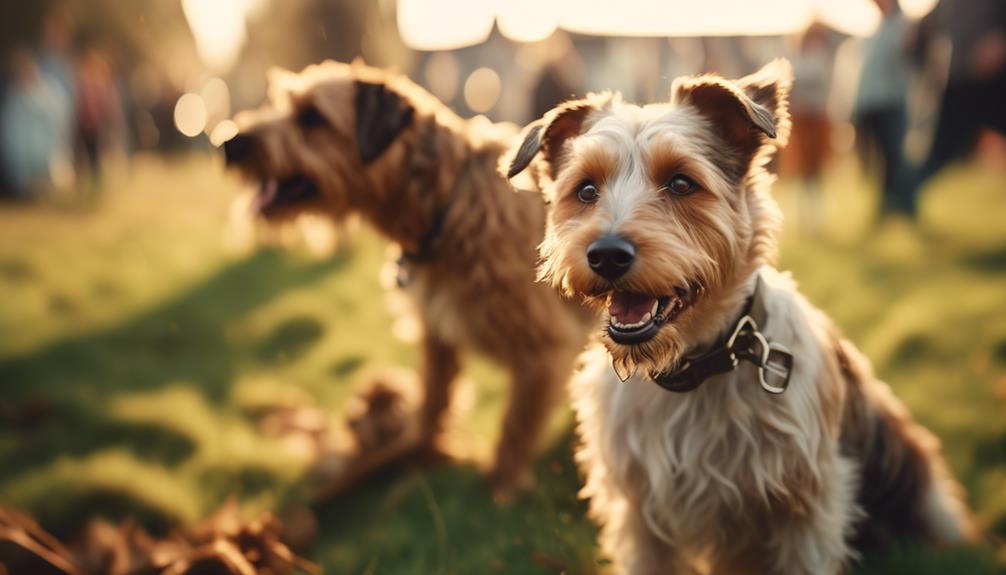
When interacting with an Irish Terrier, you can expect affection, loyalty, and unconditional love. These dogs are known for their devotion to their human companions and their strong bond with their families.
Irish Terriers may prefer to be the solo pet in the home, but with early socialization, they can warm up to other dogs and pets. They require plenty of attention, patience, and space to move around.
It's important to note that dog aggression towards humans can be a serious issue, especially for dogs with predatory instincts. Prey drive should be considered when choosing a breed, as some dogs have a low prey drive. Additionally, some breeds are more prone to barking or howling, so the breed's vocalization frequency should be taken into account.
Prey Drive and Barking Tendencies
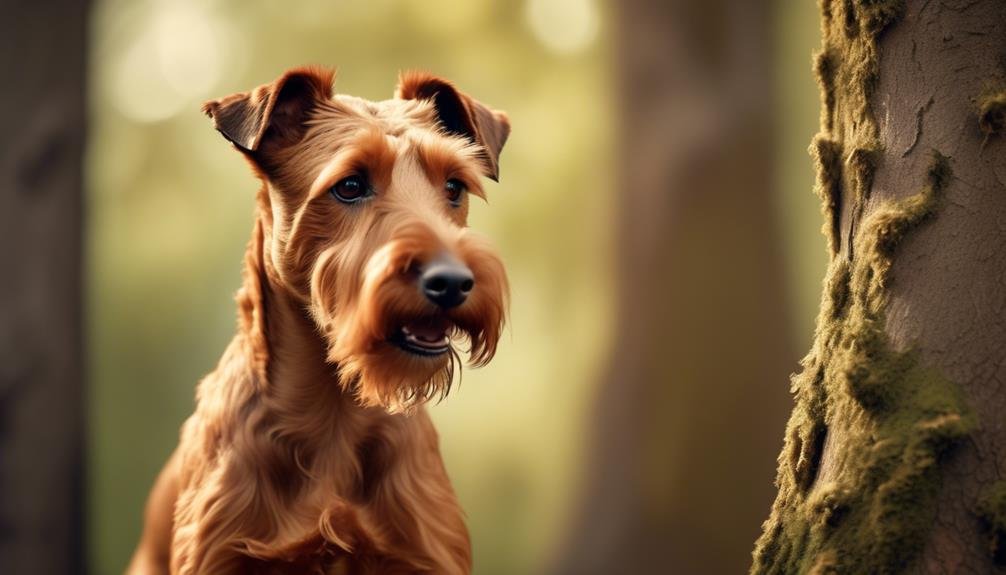
As you learn more about the Irish Terrier's personality and interaction, it's important to understand their prey drive and barking tendencies. Here are some key points to consider:
- Prey Drive:
- Some dogs have low prey drive, while others have a strong instinct to chase and capture prey.
- Irish Terriers fall somewhere in between, with a moderate prey drive.
- This means they may be inclined to chase small animals, such as squirrels or rabbits, if given the opportunity.
- It's essential to keep them on a leash or in a securely fenced area to prevent them from running off after potential prey.
- Barking Tendencies:
- Like many terrier breeds, Irish Terriers can be prone to barking.
- They have a strong sense of alertness and may bark to communicate or warn of perceived threats.
- Early training and socialization can help manage their barking tendencies.
- Providing mental and physical exercise can also help reduce excessive barking.
Understanding these aspects of the Irish Terrier's behavior will help you better care for and train your furry companion.
Energy Levels and Activity Requirements
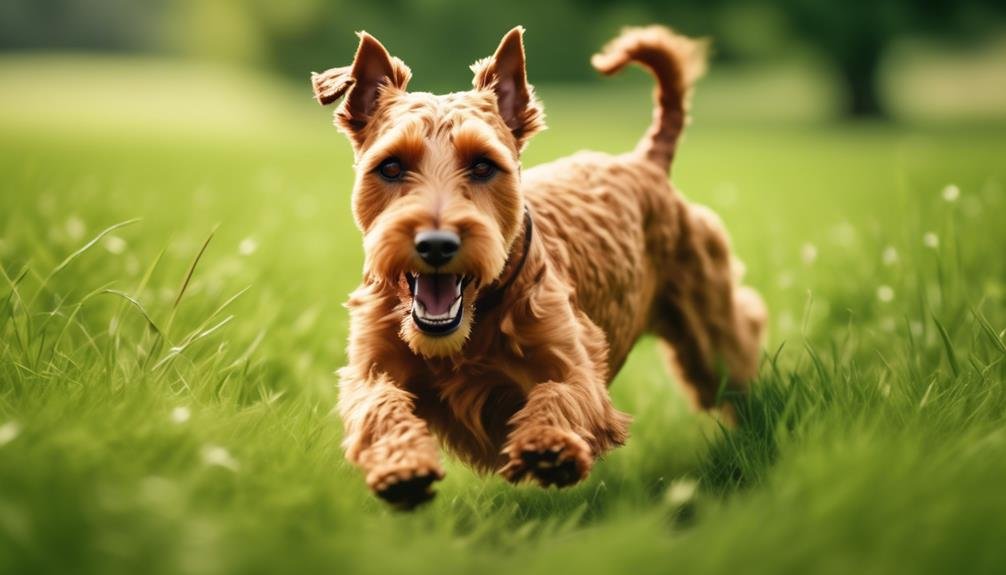
The Irish Terrier is a breed known for its energy levels and activity requirements. These dogs have a moderate exercise need and thrive on physical activity. Daily walks and mental stimulation are essential to keep them happy and healthy.
They enjoy playing games and participating in activities such as agility, obedience, and tracking. Their high energy levels make them excellent companions for active individuals or families who can provide them with plenty of exercise.
Irish Terriers aren't suited for a sedentary lifestyle and may become bored or develop behavioral problems if their activity needs aren't met. It's important to ensure that they have enough space to move and play, as well as opportunities for socialization with other dogs.
Regular exercise won't only keep them physically fit but also mentally stimulated, helping to prevent boredom and destructive behaviors.
Irish Terrier History and Care
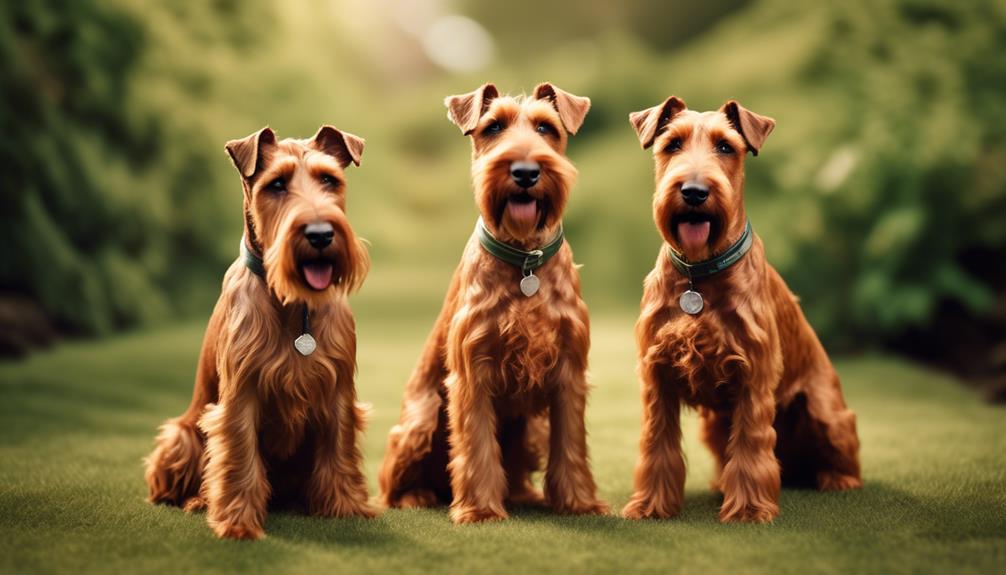
To understand the history and care of Irish Terriers, let's delve into their origins and the specific needs they require as a breed.
- Origins: Irish Terriers are one of the oldest Terrier breeds, with ancestors including the now-extinct black and tan Terrier and a larger wheaten-colored terrier. They emerged as a recognized breed in 1875, with two Irish Terriers, Ch. Erin and Killney Boy, considered the foundation of the breed. In the 1880s, they were the fourth most popular breed in Britain.
- Size: The ideal weight for males is 27 pounds and for females is 25 pounds, with a height at the shoulder of 18 to 20 inches.
- Health: Irish Terriers are generally considered a healthy breed, but potential health issues include hip dysplasia, elbow dysplasia, hypothyroidism, von Willebrand's disease, and thrombopathia. Health clearances for parents should be obtained from a reputable breeder.
- Care: Irish Terriers require moderate exercise, with two or three walks on a leash per day. They should live indoors with sufficient exercise, as they can become prone to barking and digging if left alone in the backyard. The breed has a dense, wiry coat that needs regular grooming to keep it healthy and reduce allergens.
Frequently Asked Questions
Are Irish Terriers Good With Children?
Irish Terriers are generally good with children. They are known for their affectionate and loyal nature towards their human companions. However, as with any dog, it is important to supervise interactions and teach children how to properly interact with dogs.
Do Irish Terriers Require a Lot of Grooming?
Yes, Irish Terriers do require a lot of grooming. Their wiry double coat needs regular brushing to prevent matting and regular hand-stripping to maintain its texture. They also need their teeth brushed and nails trimmed regularly.
Can Irish Terriers Live in Hot Climates?
Yes, Irish Terriers can live in hot climates, but they may require extra care to stay cool. Provide plenty of shade, access to fresh water, and avoid excessive exercise during the hottest parts of the day.
Are Irish Terriers Prone to Separation Anxiety?
Yes, Irish Terriers can be prone to separation anxiety. They are known for their loyalty and attachment to their human companions, so being left alone for long periods of time can cause distress.
Do Irish Terriers Make Good Guard Dogs?
Yes, Irish Terriers make good guard dogs. They are known for their fearless nature and loyalty, which makes them alert and protective. Their strong instincts and tendency to bark make them excellent at alerting their owners to potential threats.
What are the key differences between Irish Terriers and Irish Setters in terms of breed characteristics and traits?
The key differences between Irish Terriers and Irish Setters lie in their breed characteristics and traits. While Irish Setters are known for their friendly and outgoing nature, Irish Terriers are more assertive and independent. Irish Setters are also larger in size and have a more energetic disposition, whereas Irish Terriers are smaller and known for their courage and loyalty. Both breeds share the common traits of being intelligent and affectionate towards their families. However, their distinct irish setter dog characteristics set them apart in terms of temperament and physical attributes.
Conclusion
In conclusion, if you're looking for a feisty, loyal, and intelligent companion, the Irish Terrier is a great choice.
With their distinctive wiry coat and medium-sized stature, these dogs are sure to capture your heart.
They require regular exercise and training, but their affectionate nature makes it all worthwhile.
While they may have some common health problems, proper care and grooming can help keep them healthy.
Consider welcoming an Irish Terrier into your home and enjoy the love and companionship they bring.




